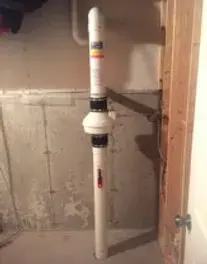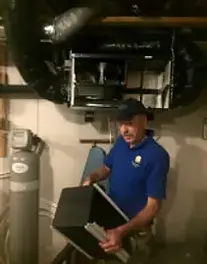
Radon Mitigation
How Does Radon Mitigation Work?
Home Assessment
Mitigation begins with a free home consultation by a Canadian National Radon Proficiency Program (C-NRPP) certified scientist.
Home Consultation
-
Your basement is evaluated to identify radon entry points, location of HRV fresh air intake, combustion appliances, and infloor plumbing.
-
Specific radon reduction strategy is explained and discussed with the homeowner.
-
Personalized quote and system design is provided and customized to your home.

Install Mitigation System
We use proven scientific methods and this is what makes us unique. We follow Health Canada guidelines to illustrate that our design is engineered to maximize efficiency and minimize cost. A sub-slab depressurization system is type normally installed to lower radon level.
Installation Process
-
A hole is cored through concrete slab, gravel/soil is identified and removed.
-
A Flow Meter Station and sub-slab pressure diagnostics are used to calculate optimum fan size.
-
PVC piping, fan, bracing, U-tube manometer and labelling are installed.
-
HRV filters are cleaned and airflow is balanced by HRAI certified technicians.
Test & Report
A post-mitigation test and comprehensive assessment report are provided.
Post Installation
-
An 96 hour test is conducted after the system is operational to confirm radon level has been successfully reduced.
-
Our goal is to reduce the radon level below 100 Bq/m3.
-
An assessment report, test plot and long-term alpha track test kit provided.
-
All work comes with a full 5 year warranty.
Sub-Slab Radon Mitigation System Installation

Coring 4" suction point in slab.

Flow Meter Station

Determining airflow with micromanometer at 3/8" test hole

A hole is drilled through the exterior wall for radon fan exhaust pipe.
4" schedule 40 PVC pipe with radon fan is installed and labelled with U-tube manometer indicated fan suction and confirming system operation.

Heat recovery ventilation systems are cleaned and airflows balanced by certified residential mechanical ventilation technicians to insure home is receiving optimum fresh air supply.

A 4 day radon test is started after the system is operational to confirm radon level has been successfully reduced below Health Canada’s 200 Bq/m3 Action Level. Our goal is to reduce level below 100 Bq/m3. A post-mitigation plot and assessment report are provided to discuss installation details and radon test results.
